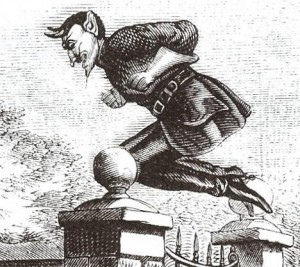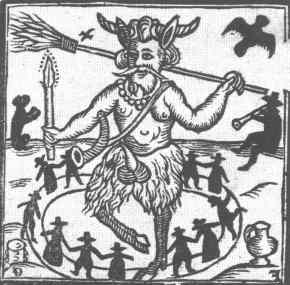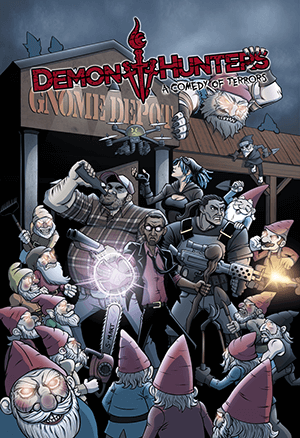Storytime with KBC: Phantom Attackers
Happy October, boys and girls! The sun’s setting earlier and earlier, the leaves and the mercury are dropping with increasing speed, and every possible form of edible or inedible material is suddenly “Pumpkin Spice” flavored. And of course with October comes every pseudohistorian’s favorite holiday: Columbus Day! Your annual reminder that “history” is just the bull$#&@ stories that managed to stick around the longest. For the rest of you though, October means Halloween. It means Trick-or-Treating, costume parties, and the only time it’s socially acceptable to make out with a sexy cat. Just be careful when you’re out there running from house to house, either begging for candy or trying to remember which house is yours through a “Pumpkin Spice Ale”-scented haze. You never know what might be lurking in the darkness.
 October, 1837. A woman in London is on her way home when a strange creature leaps out of an alley, grabs her, and tears at her clothes with its claws. It runs away when she screams for help. The next day the same creature jumps in front of a carriage, causing the driver to crash. It escapes the scene by leaping over a nine foot high wall. The press, not about to let a chance at sensationalism slip past them, gives the creature a name: Spring-Heeled Jack.
October, 1837. A woman in London is on her way home when a strange creature leaps out of an alley, grabs her, and tears at her clothes with its claws. It runs away when she screams for help. The next day the same creature jumps in front of a carriage, causing the driver to crash. It escapes the scene by leaping over a nine foot high wall. The press, not about to let a chance at sensationalism slip past them, gives the creature a name: Spring-Heeled Jack.
A year later Jane Alsop answers a knock at the door, expecting whatever the 19th century equivalent of Jehovah’s Witnesses were, and instead comes face to face with Spring-Heeled Jack himself. She later describes him as wearing a large helmet and a tight, oilskin suit. His eyes blazing red, he spews blue fire from his mouth and lunges at her, tearing at her with metallic claws. Jane screams for help, and Jack flees into the night as her sister arrives. A few nights later Jack attacks another young woman, Lucy Scales, who also describes him shooting blue flames from his mouth. The Jack Attacks continue for many decades, with seemingly no rhyme or reason to them. The last definitive Spring-Heeled Jack sighting was in Liverpool in 1904, but there have been supposed sightings as recently as two years ago.
 December, 1933. The inaccurately named “Mad Gasser of Mattoon” began the first round of his attacks in Botetourt County, Virginia, pumping a noxious, unidentified gas into the home of the Huffman family, causing nausea, headaches, and facial swelling. Eleven similar attacks would take place over the next three months, but it would be a full decade before the Mad Gasser of Mattoon actually made it to Mattoon, Illinois.
December, 1933. The inaccurately named “Mad Gasser of Mattoon” began the first round of his attacks in Botetourt County, Virginia, pumping a noxious, unidentified gas into the home of the Huffman family, causing nausea, headaches, and facial swelling. Eleven similar attacks would take place over the next three months, but it would be a full decade before the Mad Gasser of Mattoon actually made it to Mattoon, Illinois.
The Mattoon gas attacks took place during the summer of 1944, with stories that matched the Botetcourt County attacks beat for beat—someone pumping a bluish, strange smelling gas into people’s homes for absolutely no reason—with an additional twist of the gas causing partial paralysis in its victims. These attacks were, again, completely random, and there seemed to be no attempt to burglarize the homes. The Gasser just seemed to really like gassing the crap out of strangers. The Mad Gasser was spotted on several occasions, with witnesses describing him as tall, thin, and dressed all in black, but managed to escape capture every time. Two weeks and twenty-one attacks later, the Mad Gasser of Mattoon disappeared for good. He was never found, and his mysterious gas was never identified.
 May, 2001. Residents of New Delhi start reporting attacks by a bizarre “Monkey-Man.” Descriptions of the creature vary wildly, with a height ranging from four to eight feet tall. Sometimes it has metal claws and red eyes. Other times it doesn’t. It’s dressed in a silver helmet, or bandages, or nothing but dark black fur. Some even claim to have seen it transform into a cat. The only consistent description is the way it parkours its way around the city, jumping between buildings with remarkable agility.
May, 2001. Residents of New Delhi start reporting attacks by a bizarre “Monkey-Man.” Descriptions of the creature vary wildly, with a height ranging from four to eight feet tall. Sometimes it has metal claws and red eyes. Other times it doesn’t. It’s dressed in a silver helmet, or bandages, or nothing but dark black fur. Some even claim to have seen it transform into a cat. The only consistent description is the way it parkours its way around the city, jumping between buildings with remarkable agility.
Several people report being attacked by the Monkey-Man and scratched with its metal claws. Two men even die fleeing from the creature, though the deaths are attributed to their panicked flight, not the creature itself. In all, fifteen people are injured in Monkey-Man attacks, and a four-foot tall sadhu is beaten by an angry mob who mistook the holy man for the Monkey-Man. Oops! By the end of the month the attacks have stopped completely, and the Monkey-Man hasn’t been seen since.
“The hell?” I hear you thinking. “Did this guy forget he’s only supposed to tell one story a month?” Nope. I am acutely aware of what I get paid to write each month. 1200 words, no more, no less. (Okay, sometimes less. They don’t seem to audit the count.) These three bizarre attackers are separated by decades and continents. Their methodologies are all over the place. What could they possibly have in common?
Faeries, man. Faeries. What a bunch of dicks.
The Fae are our terrestrial neighbors. We share the same planet, but they usually inhabit a plane of existence about a quarter-turn to the left of ours, although they can cross over to our side whenever they feel like it. Faeries are native to Europe, and largely concentrated in the British Isles, but these days you can find them pretty much anywhere. When the Brits went on their little colonial world tour, the faeries came along for the ride.
 We’re not talking about all faeries here though. These Phantom Attacker cases are usually the work of pookas. You’d probably know them better as pucks. Yeah, the dude from the play. Shakespeare’s Puck is actually a pretty damn good representation of the species. Malicious little trickster bastards who delight in screwing with humanity. They’re shapeshifters too, with one hell of an imagination—hence the wide range of weird appearances. Pucks don’t need a reason to mess with humans—it just comes naturally to them.
We’re not talking about all faeries here though. These Phantom Attacker cases are usually the work of pookas. You’d probably know them better as pucks. Yeah, the dude from the play. Shakespeare’s Puck is actually a pretty damn good representation of the species. Malicious little trickster bastards who delight in screwing with humanity. They’re shapeshifters too, with one hell of an imagination—hence the wide range of weird appearances. Pucks don’t need a reason to mess with humans—it just comes naturally to them.
There’ve been plenty of other Phantom Attacker cases in history. Most lack a clearly supernatural aspect that would definitely mark it as the work of a puck, but there’s a few that I’d say are a pretty safe bet. There’s the London Monster, who’d offer to let his victims smell his flower before stabbing them in the face with a hidden spike. Or Whipping Tom, who’d yank up women’s dresses and lash them across the ass with a leather whip, shouting “SPANKO!” And there’s the Halifax Slasher, who—
Hahahahahahaha! I’m sorry…I…I just…“SPANKO!” Hahahaha! That…that is @#$&ing hilarious! Hell of a catch phrase, Tom! *whipcrack* “SPANKO!” Hahahaha!
Anyway, “SPANKO!” is funny and faeries are @$$holes. That’s all I’m trying to say.
So remember kids, play it safe out there. Most of the metal claw weirdos out there on Halloween are just Wolverine fans, but you never know. Spring-Heeled Jack was never caught, and pucks live a long damn time! Now scram, I’m starving! There’s a steakhouse near here that serves a great Pumpkin Spice porterhouse this time of year. Until next time, fellow “history” buffs.
– KBC

 About the Author:
About the Author:





Darn it, my money was on aliens!
Anyhoo, myths, legends and folktales may be blown entirely out of proportion in subsequent re-tellings and embelishments, but essentially somebody saw or experienced *something* that spawned those hysterical narratives. Thankfully, we have the benefit of a chronomeister willing to dig through dusty, 19th-century filing cabinets for the REAL stories. ^_^
Dear KBC,
Do you have some fun time story about Nikola Tesla?
Sincerely
Obviously not your future grandson….please